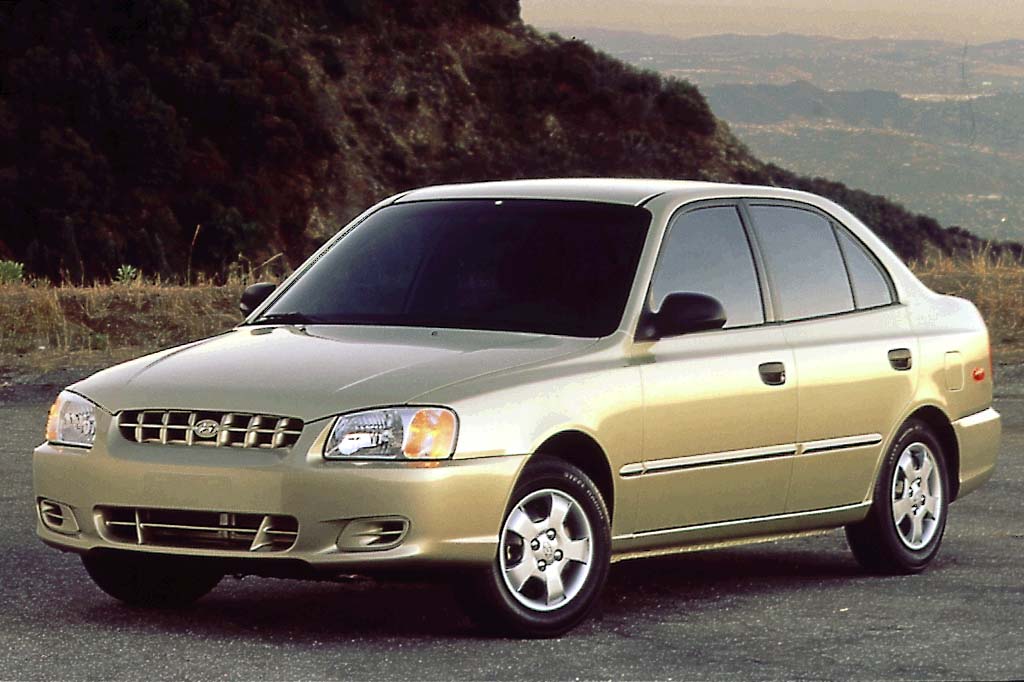| Compact car; Built in South Korea |
|
|
| Good condition price range: $1,500 – $4,200* |

2000 Hyundai Accent 4-door sedan

2000 Hyundai Accent 2-door hatchback

2001 Hyundai Accent 2-door hatchback

2001 Hyundai Accent 4-door sedan

2000 Hyundai Accent 4-door sedan
| Pros: |
|
| Cons: |
|
Affordable without seeming cheap, an Accent is worth considering as a bargain-basement commuter car. Because it trails most non-Korean brands in resale value, used-car prices can be appealing. Most rivals offer better performance and refinement for a little more money.
Overview
Redesigned and slightly enlarged for 2000, Hyundai’s smallest and least-expensive model also featured fresh styling. Wheelbase grew by 1.6 inches. The new Accent was about 5 inches longer than before, almost 2 inches wider, and up to 192 pounds heavier. Interior and cargo volumes were little-changed. Hyundai’s front-drive subcompact competed against the Chevrolet Metro, Ford Focus, Honda Civic, Nissan Sentra, Mitsubishi Mirage, Toyota Echo, Daewoo Lanos, and Kia Rio.
Two body styles were offered: a two-door hatchback in base or GS trim, and a four-door sedan that came only in top-level GL guise. The 1.5-liter four-cylinder engine produced 92 horsepower, with a standard five-speed manual transmission. A four-speed automatic transmission, optional in GS and GL models, featured Hyundai’s Adaptive Logic, which was designed to limit unnecessary gear changes on grades or while decelerating.
Hyundai claimed that the new-generation Accent was less noisy, smoother, with a better transmission. Reinforced A- and B-pillars were installed, and the cowl crossbar was strengthened. Double-sealed doors also were installed.
Head, leg, and hip room were said to be improved. Accents got a 60/40 rear seat, new instrument panel and gauges, and a new steering wheel. GS and GL models included a tachometer, tinted glass, clock, and five-way adjustable seat. Options included air conditioning, power windows, power locks, power mirrors, and CD player.
Accent was one of the few mainstream passenger cars that did not offer antilock braking. The low-end L edition didn’t even have power brakes as standard equipment, but all models had power steering.
Hyundai offered one of the industry’s longest warranties: 5-years/60,000-miles bumper-to-bumper, and 10-years/100,000-miles for the powertrain.
Yearly Updates
| 2001 Accent Some Accents got a bigger engine this year. Supplanting the GS two-door hatchback, the base Accent L kept the previous 92-horsepower, 1.5-liter four-cylinder. GS and GL models got a twin-cam, 1.6-liter engine that produced 105 horsepower. Topping the line was the GL four-door sedan. An automatic transmission was optional in all but the L model, which came only with manual shift. Power brakes now were standard in the L. |
| 2002 Accent Air conditioning became standard on GS and GL editions and optional for the L this year. The Accent lineup again included the base L two-door hatchback with its 1.5-liter engine and manual shift, plus the GS hatchback and GL four-door sedan with a 1.6-liter four and either manual or automatic transmission. |
| 2003 Accent All models got a mild facelift with revised front and rear styling. Base hatchback now uses the same 1.6-liter 4-cyl engine as other Accents. It comes only with manual transmission. Side airbags were added to some models late in the model year. |
| 2004 Accent The accent is unchanged for 2004. |
| 2005 Accent Accent gets available antilock brakes for 2005. For ’05, ABS is offered in a $1685 option package that also includes air conditioning, power windows and locks, and a CD player. |
